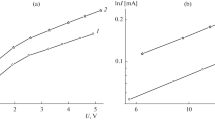Abstract
Modulators of terahertz range on the base of silicon integrated p-i-n-structures are investigated theoretically. The generalization of the Fletcher boundary conditions at the injecting contacts has been put forward for the case of highly doped p ++, n ++ regions, where both forbidden gap narrowing and dependence of coefficients of diffusion on doping concentration are taken into account. The problem of double injection into i-region has been simulated in a two-dimensional case. The investigations of modulation properties of integrated p-i-n-structures in the terahertz range have demonstrated a possibility to use these structures up to the frequencies 8 THz.
Similar content being viewed by others
References
P. Siegel, “Terahertz technology,” IEEE Trans. Microwave Theory Tech. 50, No. 3, 910 (2002).
P. Siegel, “THz technology in biology and medicine,” IEEE Trans. Microwave Theory Tech. 52, No. 10, 2438 (2004).
F. Rodriguez-Morales, K. S. Yngvesson, R. Zannoni, et al., “Development of integrated HEB/MMIC receivers for near-range terahertz imaging,” IEEE Trans. Microwave Theory Tech. 54, No. 6, 2301 (2006).
S. Wang and X.-C. Zhang, “Pulsed terahertz tomography (Topical review),” J. Phys. D: Appl. Phys. 37, No. 1, R1 (2004).
S. Koshevaya, E. Gutierrez-D., M. Hayakawa, et al., “Interaction of powerful electromagnetic waves with integrated p-i-n-structures,” Japan. J. Appl. Phys. 37, No. 5, 643 (1998).
S. V. Koshevaya, Ya. I. Kishenko, M. I. Smoilovskii, and V. A. Trapezon, “Fast wideband modulators on p-i-n structures,” Izv. Vyssh. Uchebn. Zaved., Radioelektron. 32(10), 21 (1989); Radioelectron. Commun. Syst. 32(10), 17 (1989).
V. L. Bonch-Bruyevich and S. G. Kalashnikov, Physics of Semiconductors (Nauka, Moscow, 1990) [in Russian].
S. Sze, Physics of Semiconductor Devices (Wiley-Interscience, New York, 1981).
New Semiconductor Materials. Characteristics and Properties, http://www.ioffe.ru/SVA/NSM/.
B. Shklovskii and A. Efros, Electronic Properties of Doped Semiconductors (Springer, Berlin, 1984).
F. Schwierz and J. Liou, Modern Microwave Transistors (Wiley, New York, 2003).
V. Vitlina and A. Dykhne, “Reflection of electromagnetic waves from a surface with a low relief,” JETP 72, No. 6, 983 (1991).
Author information
Authors and Affiliations
Additional information
Original Russian Text © V.V. Grimalsky, S.V. Koshevaya, M. Tecpoyotl-T., 2010, published in Izv. Vyssh. Uchebn. Zaved., Radioelektron., 2010, Vol. 53, No. 6, pp. 31–39.
Authors would like to thank Professor A. Vertiy for useful discussions. Work was supported by SEP-CONTACyT (Mexico).
About this article
Cite this article
Grimalsky, V.V., Koshevaya, S.V. & Tecpoyotl-T, M. Integrated silicon p-i-n structures with highly doped p ++, n ++ regions for modulation in terahertz frequency band. Radioelectron.Commun.Syst. 53, 309–316 (2010). https://doi.org/10.3103/S073527271006004X
Revised:
Published:
Issue Date:
DOI: https://doi.org/10.3103/S073527271006004X



